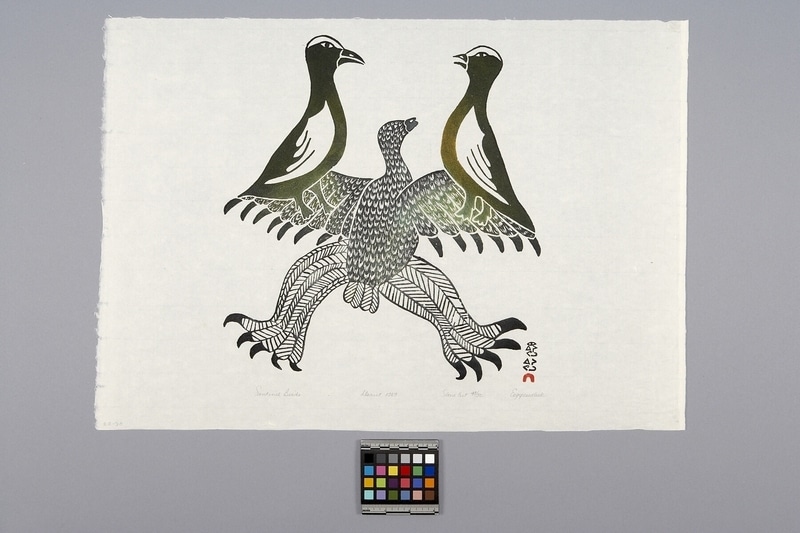Sentinel Birds Item Number: Na757 from the MOA: University of British Columbia

Description
Print depicting a large bird with wings spread and legs extended, and two smaller birds each sitting on one of the large bird's wings. The small birds have black bodies graduating to green and dark yellow with white wings. The large bird has a white feather pattern on its dark blue and green body and wings, with solid wingtips and legs that have bands of diagonal dark green and blue-black patterns on white with black claws. Below the image is written, "Sentinel Birds Dorset 1969 Stone cut 43/50 Eegyvudluk." The artist and printmaker's names are printed in Inuit syllabics along with the Cape Dorset stylized red igloo seal at the lower right-hand side. "22-70" is written at the bottom corner on the left. Blind embossed Canadian Exkimo Arts Council logo is in bottom right-hand corner.
History Of Use
Contemporary Inuit prints were first produced at Cape Dorset in 1957. Although precursors to printmaking can be seen in women's skin applique work and in men's incising of ivory, stone and bone, the impetus for printmaking was as a commercial venture. This venture was established jointly by Inuit artists and John Houston, the civil administrator for Cape Dorset. Other Inuit communities quickly followed the commercial success of Cape Dorset's West Baffin Eskimo Cooperative. Printmaking developed as a communal activity following a Japanese, rather than a Western, model of serigraph production. Each year the cooperatives produce a series of limited edition prints which are sold in the retail art market. In 1965, the Canadian Eskimo Arts Council was established from the Canadian Eskimo Art Committee to ensure high standards were maintained. Printmaking, along with stone carving, provide cash income for communities which have undergone rapid and significant change, during the late 20th century, from traditional hunting based societies to settled communities dependent on consumer goods. The prevalent images depicted in Inuit art are of traditional life, arctic animals and mythology. Recently, contemporary subjects have been depicted by a minority of artists.
Cultural Context
contemporary art
Item History
- Made by Eegyvudluk Pootoogook (Maker) in Cape Dorset, Nunavut, Canada and Kinngait, Nunavut, Canada during 1969
- Collected before 1983
- Owned by Guenter Adolphs before December 15, 1983
- Received from Guenter Adolphs (Donor) on December 15, 1983
What
Who
- Culture
- Inuit
- Creator
- Eegyvudluk Pootoogook (Maker)
- Previous Owner
- Guenter Adolphs
- Received from
- Guenter Adolphs (Donor)
Where
- Holding Institution
- MOA: University of British Columbia
- Made in
- Cape Dorset, Nunavut, Canada and Kinngait, Nunavut, Canada
When
- Creation Date
- during 1969
- Collection Date
- before 1983
- Ownership Date
- before December 15, 1983
- Acquisition Date
- on December 15, 1983
Other
- Item Classes
- works on paper
- Condition
- good
- Accession Number
- 0914/0027